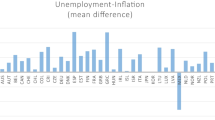Summary
This paper investigates some of the difficulties of using Almon's technique in the estimation of distributed lags. After a theoretical discussion of the Almon model, formulated both in terms of transformation of the independent variable(s) and as a set of constraints on the parameters, a critical analysis of the conventional criteria for choosing the “best” model (such as goodness of fit, the statistical significance of the individual parameter estimate or their sums, and an analysis of autocorrelation) demonstrates the problems of choosing the appropriate combination of lag length and degree of polynomial.
These problems are illustrated by an empirical example, which re-estimates some equations from an earlier study of financial capital flows in the U.S. balance of payments.
Similar content being viewed by others
References
Almon, S.: The distributed lag between capital appropriations and expenditures. Econometrica22, 1965, 178–196.
—: Lags between investment decisions and their causes. Review of Economic and Statistics50, 1968, 193–206.
Anderson, L.C., andK.M. Carlson: A monetarist model for economic stabilisation. Federal Reserve Bank of St. Louis Review52, 1970, 7–25.
Anderson, L.C., andJ.L. Jordan: Monetary and fiscal actions: a test of their relative importance in economic stabilisation. Federal Reserve Bank of St. Louis Review50, 1968, 11–24.
Branson, W.H.: Financial capital flows in the U.S. balance of payments. Amsterdam 1968.
Cargill, T.F., andR.A. Meyer: Some time and frequency domain distributed lag estimators; a comparative Monte Carlo study. Econometrica42, 1974, 1031–44.
Corrigan, E.G.: The measurement and importance of fiscal policy changes. Monthly Reveiw, Federal Reserve Bank of New York, June 1970, 133–45.
Davis, R.G.: How much does money matter? A look at some recent evidence. Monthly Review, F.R.B. of New York, June 1969, 119–31.
Dhrymes, P.J.: Distributed lags: problems of estimation and formulation. New York 1971.
Dickson, H.D., andD.R. Starleaf: Polynomial distributed lag structures in the demand function for money. Journal of Finance27, 1972, 1035–43.
Frost, P.A.: Some properties of the Almon lag technique when one searches for degree of polynomial and lag. Journal of the American Statistical Association70, 1975, 606–612.
Godfrey, L.G., andD.S. Poskitt: Testing the restrictions of the Almon lag technique. Journal of the American Statistical Association70, 1975, 105–108.
Keran, M.W.: Monetary and fiscal influences on economic activity — the historical evidence. Federal Reserve Bank of St. Louis Review51, 1969, 5–23.
Lombra, R.E., andR.G. Torto: Measuring the impact of monetary and fiscal actions; a new look at the specification problem. Review of Economics and statistics56, 1974, 104–7.
Maddala, G.S.: Some notes on discrimination between different distributed lag models. CORE Discussion Paper No. 7109, Louvain 1971.
Pesaran, M.H.: The small sample problem of truncation remainders in the estimation of distributed lag models with autocorrelated errors. International Economic Review14, 1973, 120–31.
Schmidt, P.: A modification of the Almon distributed lag. Journal of the American Statistical Association69, 1974, 679–81.
Schmidt, P., andR.N. Waud: The Almon lag technique and the monetary versus fiscal policy debate. Journal of the American Statistical Association68, 1973, 11–19.
Shiller, R.J.: A distributed lag estimator derived from smoothness priors. Econometrica41, 1973, 775–88.
Silber, W.L.: The St. Louis equation: “Democratic” and “Republican” versions and other experiements. Review of Economics and Statistics53, 1971, 362–67.
Teräsvirta, T.: A note on bias in the Almon distributed lag estimator. Econometrica44, 1976, 1317–1321.
Theil, H.: Economic forecasts and policy, 2nd edition. Amsterdam 1961.
Thomas, J.J.: Some problems in the use of Almon's technique in the estimation of distributed lags. Institut des Sciences Economiques Discussion Paper No. 7508, Louvain 1975.
Trivedi, P.K.: A note on the application of Almon's method of calculating distributed lag coeffcients, Metroeconomica22, 1970, 281–6.
Wickens, M.R., andJ.N. Greenfield: The econometrics of agricultural supply: an application to the world coffee market. Review of Economics and Statistics55, 1973, 433–440.
Yeo, J.S.: Testing the length of the Almon lag using the Anderson procedure, Mimeograph, Jan. 1976.
Author information
Authors and Affiliations
Additional information
An earlier and more extensive version of this paper appeared as a Working Paper, [Thomas]. The author is grateful toM.J. Desai andR.W. Farebrother for their comments on that paper. Needless to say, all errors here are the author's responsibility.
Rights and permissions
About this article
Cite this article
Thomas, J.J. Some problems in the use of Almon's technique in the estimation of distributed lags. Empirical Economics 2, 175–193 (1977). https://doi.org/10.1007/BF01760398
Received:
Revised:
Issue Date:
DOI: https://doi.org/10.1007/BF01760398




